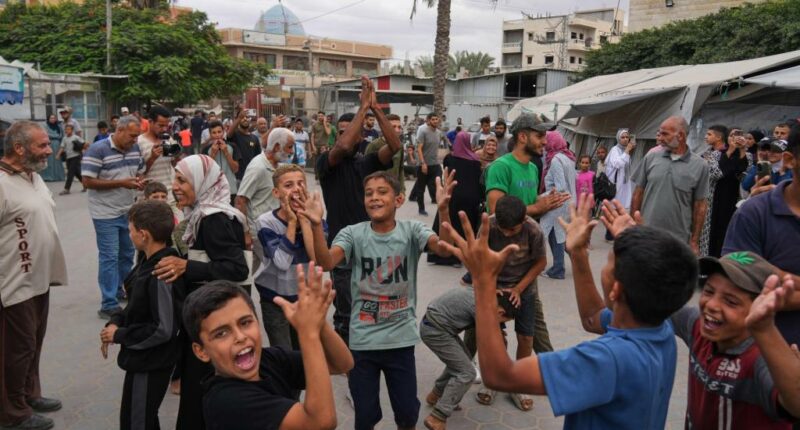Share this @internewscast.com
By SAMY MAGDY, MELANIE LIDMAN and WAAFA SHURAFA, Associated Press
CAIRO (AP) — An agreement has been reached between Israel and Hamas to pause their devastating two-year conflict and exchange hostages for Palestinian prisoners. This development, while bringing joy and relief on Thursday, is also met with caution.
Questions persist regarding the more complex parts of the plan advanced by U.S. President Donald Trump’s administration — specifically, how Hamas will disarm and who will take governance of Gaza. Nonetheless, both parties seem closer than they have been in recent months to halting a war that has claimed tens of thousands of Palestinian lives, turned much of Gaza into ruins, led to famine in the region, and sparked additional conflicts throughout the Middle East.
The conflict, initiated by a deadly Hamas attack on Israel on October 7, 2023, has not only stirred global protests but has also led to accusations against Israel of genocide, which the nation refutes.
Even as the signing of the agreement in Egypt is anticipated later today, Israeli airstrikes continued, with explosions reported in northern Gaza on Thursday, although there were no immediate accounts of damages or casualties.

An Israeli military source, who preferred to remain unnamed per military protocols, mentioned that Israel is still targeting threats to its forces as they relocate.
In the southern Gaza city of Khan Younis, celebrations were relatively muted and often colored by grief.
“I am torn between happiness and sorrow. We have suffered immense losses, losing our homes and those dear to us,” expressed Mohammad Al-Farra. “Even as we celebrate, we cannot ignore the uncertainty of our future… The areas we hope to return to are now uninhabitable.”
In Tel Aviv, families of the remaining hostages popped champagne and cried tears of joy after Trump announced on social media late Wednesday that “ALL of the Hostages will be released very soon, and Israel will withdraw their Troops to an agreed upon line.”
On Thursday, thousands of observant Jews streamed into Jerusalem’s Old City to mark the holiday of Sukkot, with extra rejoicing for the upcoming hostage release.
“We were screaming and singing last night,” said Hindel Berman, a New Jersey resident who came to Jerusalem for the holiday. “We never, never, never gave up hope.”
Under the terms, Hamas intends to release all 20 living hostages in a matter of days, while the Israeli military will begin a withdrawal from the majority of Gaza, people familiar with the matter told The Associated Press on condition of anonymity to discuss details of an agreement that has not fully been made public.
“With God’s help we will bring them all home,” Israeli Prime Minister Benjamin Netanyahu proclaimed on social media.
Netanyahu plans to convene his Security Cabinet late Thursday to approve the ceasefire, and the entire parliament will then meet to approve the release of Palestinian prisoners.
The deal will include a list of prisoners to be released and maps for the first phase of an Israeli withdrawal to new positions in Gaza, according to two Egyptian officials briefed on the talks, a Hamas official and another official.
Israel will publish the list of the prisoners — and victims of their attacks have 24 hours to lodge objections.
The withdrawal could start as soon as Thursday evening, said the officials, who spoke on condition of anonymity because they were not authorized to be publicly named speaking about the negotiations.
The hostage and prisoner releases are expected to begin Monday, the officials from Egypt and Hamas said, though the other official said they could occur as early as Sunday night.
Five border crossings would reopen, including the Rafah crossing between Gaza and Egypt, allowing 400 trucks in the initial days and increasing to 600 trucks after that, the Egyptian and Hamas officials said.
Trump is expected in the region in the coming days.
Far-right Israeli Finance Minister Bezalel Smotrich, who has opposed previous ceasefire deals, said he had “mixed emotions.”
While he welcomed the return of the hostages, he said he had “immense fear about the consequences of emptying the jails and releasing the next generation of terrorist leaders” and said that as soon as the hostages are returned, Israel must continue trying to eradicate Hamas and ensure Gaza is demilitarized.
Hamas, meanwhile, called on Trump and the mediators to ensure that Israel implements “without disavowal or delay” the troop withdrawal, the entry of aid into Gaza and the exchange of prisoners.
Trump’s peace plan
The Trump plan calls for an immediate ceasefire and release of the 48 hostages that Hamas still hold from their attack on Israel two years ago. Some 1,200 people were killed by Hamas in that assault, and 251 were taken hostage. Israel believes around 20 of the hostages are still alive.

Under the plan, Israel would maintain an open-ended military presence inside Gaza, along its border with Israel. An international force, comprised largely of troops from Arab and Muslim countries, would be responsible for security inside Gaza. The U.S. would lead a massive internationally funded reconstruction effort in Gaza.
The plan also envisions an eventual role for the Palestinian Authority — something Netanyahu has long opposed. But it requires the authority, which administers parts of the West Bank, to undergo a sweeping reform program that could take years to implement.
The Trump plan is even more vague about a future Palestinian state, which Netanyahu firmly rejects.
More than 67,000 Palestinians have been killed in Gaza and nearly 170,000 wounded during the war, according to Gaza’s Health Ministry, which doesn’t differentiate between civilians and combatants but says around half of the deaths were women and children. The ministry is part of the Hamas-run government, and the United Nations and many independent experts consider its figures to be the most reliable estimate of wartime casualties.
Relief at a deal
Even with many details yet to be agreed, many expressed relief at the progress.
In Tel Aviv, joyful relatives of hostages and their supporters spilled into the central square that has become the main gathering point in the effort to free the captives.

Einav Zangauker, the mother of Israeli captive Matan Zangauker and a prominent advocate for the hostages’ release, told reporters that she wants to tell her son she loves him.
“If I have one dream, it is seeing Matan sleep in his own bed,” she said.
From the central Gaza city of Deir al-Balah, Alaa Abd Rabbo called the announcement “a godsend.”
“This is the day we have been waiting for,” said Abd Rabbo, who was originally from northern Gaza but was forced to move multiple times during the war. “We want to go home.”
This would be the third ceasefire since the start of the war. The previous two also saw hostages and prisoners exchanged. Israel ended the most recent ceasefire, which started in January, with a surprise bombardment in March.
Ayman Saber, a Palestinian from Khan Younis, said he plans to return to his home city and try to rebuild his house, which was destroyed last year by an Israeli strike.
“I will rebuild the house, we will rebuild Gaza,” he said.
Lidman reported from Tel Aviv, Israel, and Shurafa from Deir al-Balah, Gaza Strip. Associated Press writers Eric Tucker and Aamer Madhani in Washington, Sarah El Deeb in Beirut, David Rising in Bangkok, Sam Mednick in Tel Aviv, Israel, and Giovanna Dell’Orto in Jerusalem contributed to this report.
Originally Published: October 9, 2025 at 7:37 AM EDT
















